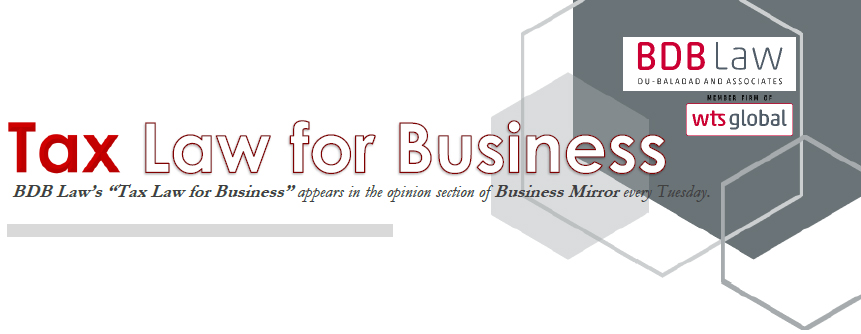
What’s in store under CREATE MORE?
By: Atty. Jomel N. Manaig
"CREATE MORE, at least in part, is the result of the clamor to clarify the confusion and inconsistencies brought about by the original CREATE and the manner it was implemented. Despite the intent of CREATE, much was left to be desired when it was implemented. CREATE MORE introduced amendments based on how CREATE fared."
After a long wait, it is finally here. Corporate Recovery and Tax Incentives for Enterprises to Maximize Opportunities for Reinvigorating the Economy, or CREATE MORE, is now a law.
CREATE MORE, at least in part, is the result of the clamor to clarify the confusion and inconsistencies brought about by the original CREATE and the manner it was implemented. Despite the intent of CREATE, much was left to be desired when it was implemented. CREATE MORE introduced amendments based on how CREATE fared.
We start with the revamped Enhanced Deduction Regime (EDR). The enhanced deductions are not really new, as it has been part of our Tax Code ever since it was introduced by the original CREATE. But back then it was just part of the incentive package and not a tax regime in its own right.
H owever, CREATE MORE placed it under the spotlight and established it as an entirely separate tax regime. Under EDR, registered business entities (RBE) would be entitled not only to additional enhanced deductions but also to a preferential income tax rate of 20% based on taxable income.
owever, CREATE MORE placed it under the spotlight and established it as an entirely separate tax regime. Under EDR, registered business entities (RBE) would be entitled not only to additional enhanced deductions but also to a preferential income tax rate of 20% based on taxable income.
This amendment is intended to address the global competitiveness of Philippine tax incentives. With this, a question arises: Is it sufficient to strengthen, or at least maintain, our competitiveness amidst the recent international tax shake-up (i.e., the Two-Pillar Solution)? I’d wager that more must be done, especially considering that the key tax features of the Two-Pillar Solution were not addressed in CREATE MORE.
Aside from the new tax regime, CREATE MORE seeks to make the investment environment significantly better.
First, it was made clear local government units (LGU) can no longer impose local fees and charges if RBEs elected either the 5% special corporate income tax (SCIT) or the 2% RBE Local Tax (RBELT). This laid to rest the question under CREATE whether LGUs may still impose local fees and charges despite the imposition of the SCIT.
Second, CREATE MORE gave us back “directly attributable” as a standard of measure for VAT-related concerns. The new law even went so far as to provide specific enumerations on what may be considered “directly attributable,” which is normally something that is not common in a law.
In CREATE, the “directly and exclusively used” standard governed the applicability of VAT exemption on importation and VAT zero-rating on local purchases. However, inconsistencies arose when the related revenue regulations were issued. This resulted in difficulties and, eventually, frustrations for RBEs, which bore the brunt of the ill-effects of these issues and inconsistencies.
Hopefully, to-be-issued revenue regulations to effect the VAT incentive provisions would stay true to the intent of the law.
CREATE MORE also provided revisions to the refund provisions. Among the changes is the introduction of another layer of remedy for taxpayers seeking refunds of VAT: the Request for Reconsideration to the Commissioner. But how effective would this remedy be? What more could be done in 15 days that could not have been done in the initial 90-day period to process? Would this really benefit taxpayers, or would this just be another bureaucratic hoop for taxpayers to hurdle?
Fortunately, the new law also requires the BIR to publish relevant statistics relative to the processing of VAT refund claims. With this, the efficiency of the Request for Reconsideration and the entire VAT refund process, for that matter, may be evaluated using measurable factors.
Another relevant amendment is the extension of periods of availment of the income tax-based incentives. For incentives granted by the investment promotion agencies (IPA), the availment period may last up to a total of 17 years, while those granted by the Fiscal Incentives Review Board (FIRB) may be availed for a total of 27 years.
While it may seem that the powers of the FIRB may have been given a significant boost, the IPAs were likewise given an expanded role by enabling them to be the initial point of contact for foreign investment leads.
These are just some of the major amendments introduced by CREATE MORE, and there is no shortage of possible nuances in its application. Too many, in fact, for us to go over all of them in a single article, but perhaps we can dabble upon it in future ones.
Though all things considered, I would say that our lawmakers really did listen to the stakeholders when they crafted the amendments. I just hope that no major issue or inconsistency will develop when it is implemented. CREATE and CREATE MORE should be enough. We wouldn’t want to have a CREATE MOST, wouldn’t we?
The author is a Partner of Du-Baladad and Associates Law Offices, a member-firm of WTS Global.
The article is for general information only and is not intended, nor should be construed as a substitute for tax, legal or financial advice on any specific matter. Applicability of this article to any actual or particular tax or legal issue should be supported therefore by a professional study or advice. If you have any comments or questions concerning the article, you may e-mail the author at jomel.manaig@bdblaw.com.ph or call 8403-2001 local 140.




